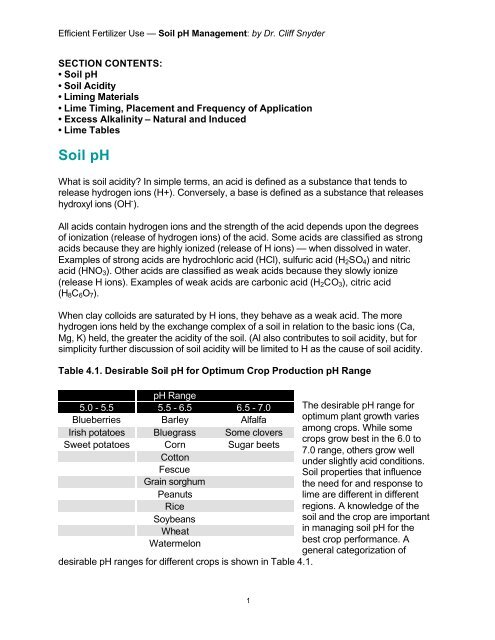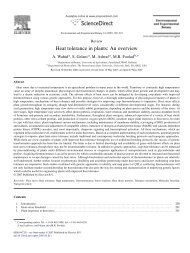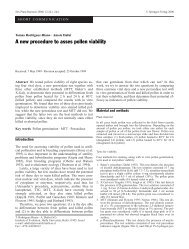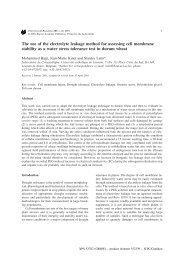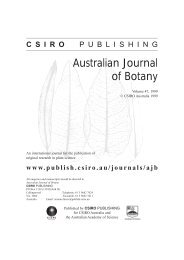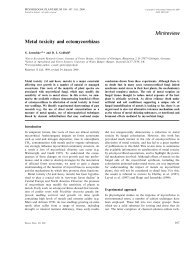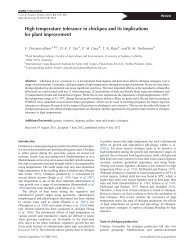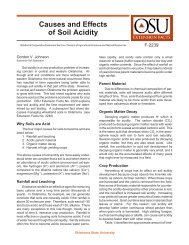Soil pH Management by Dr. Cliff Snyder - Plantstress.com
Soil pH Management by Dr. Cliff Snyder - Plantstress.com
Soil pH Management by Dr. Cliff Snyder - Plantstress.com
Create successful ePaper yourself
Turn your PDF publications into a flip-book with our unique Google optimized e-Paper software.
Efficient Fertilizer Use — <strong>Soil</strong> <strong>pH</strong> <strong>Management</strong>: <strong>by</strong> <strong>Dr</strong>. <strong>Cliff</strong> <strong>Snyder</strong><br />
SECTION CONTENTS:<br />
• <strong>Soil</strong> <strong>pH</strong><br />
• <strong>Soil</strong> Acidity<br />
• Liming Materials<br />
• Lime Timing, Placement and Frequency of Application<br />
• Excess Alkalinity – Natural and Induced<br />
• Lime Tables<br />
<strong>Soil</strong> <strong>pH</strong><br />
What is soil acidity? In simple terms, an acid is defined as a substance that tends to<br />
release hydrogen ions (H+). Conversely, a base is defined as a substance that releases<br />
hydroxyl ions (OH - ).<br />
All acids contain hydrogen ions and the strength of the acid depends upon the degrees<br />
of ionization (release of hydrogen ions) of the acid. Some acids are classified as strong<br />
acids because they are highly ionized (release of H ions) — when dissolved in water.<br />
Examples of strong acids are hydrochloric acid (HCl), sulfuric acid (H 2 SO 4 ) and nitric<br />
acid (HNO 3 ). Other acids are classified as weak acids because they slowly ionize<br />
(release H ions). Examples of weak acids are carbonic acid (H 2 CO 3 ), citric acid<br />
(H 8 C 6 O 7 ).<br />
When clay colloids are saturated <strong>by</strong> H ions, they behave as a weak acid. The more<br />
hydrogen ions held <strong>by</strong> the exchange <strong>com</strong>plex of a soil in relation to the basic ions (Ca,<br />
Mg, K) held, the greater the acidity of the soil. (Al also contributes to soil acidity, but for<br />
simplicity further discussion of soil acidity will be limited to H as the cause of soil acidity.<br />
Table 4.1. Desirable <strong>Soil</strong> <strong>pH</strong> for Optimum Crop Production <strong>pH</strong> Range<br />
<strong>pH</strong> Range<br />
5.0 - 5.5 5.5 - 6.5 6.5 - 7.0<br />
Blueberries Barley Alfalfa<br />
Irish potatoes Bluegrass Some clovers<br />
Sweet potatoes Corn Sugar beets<br />
Cotton<br />
Fescue<br />
Grain sorghum<br />
Peanuts<br />
Rice<br />
Soybeans<br />
Wheat<br />
Watermelon<br />
desirable <strong>pH</strong> ranges for different crops is shown in Table 4.1.<br />
The desirable <strong>pH</strong> range for<br />
optimum plant growth varies<br />
among crops. While some<br />
crops grow best in the 6.0 to<br />
7.0 range, others grow well<br />
under slightly acid conditions.<br />
<strong>Soil</strong> properties that influence<br />
the need for and response to<br />
lime are different in different<br />
regions. A knowledge of the<br />
soil and the crop are important<br />
in managing soil <strong>pH</strong> for the<br />
best crop performance. A<br />
general categorization of<br />
1
Efficient Fertilizer Use — <strong>Soil</strong> <strong>pH</strong> <strong>Management</strong>: <strong>by</strong> <strong>Dr</strong>. <strong>Cliff</strong> <strong>Snyder</strong><br />
<strong>Soil</strong>s be<strong>com</strong>e acid when basic elements, such as calcium, magnesium, sodium, and<br />
potassium held <strong>by</strong> soil colloids are replaced <strong>by</strong> hydrogen ions. <strong>Soil</strong>s formed under<br />
conditions of high annual rainfall are more acid than are soils formed under more arid<br />
conditions. Most southeastern soils were formed under the former condition.<br />
Consequently, they are inherently more acid than soils of the midwest and far west.<br />
<strong>Soil</strong>s formed under low rainfall conditions tend to be basic with soil <strong>pH</strong> readings around<br />
7.0 However, intensive farming over a number of years with nitrogen fertilizers or<br />
manures can result in soil acidification. In the wheat growing regions of Kansas and<br />
Oklahoma for example, soil <strong>pH</strong> of 5.0 and below, aluminum toxicity in wheat, and good<br />
response to liming have been documented in recent years.<br />
<strong>Soil</strong> Acidity<br />
Rainfall Contributes to <strong>Soil</strong> Acidity<br />
Water (H 2 O) <strong>com</strong>bines with carbon dioxide (CO 2 ) to form a weak acid — carbonic acid<br />
(H 2 CO 3 - ). The weak acid ionizes, releasing hydrogen (H + ) and bicarbonate (HCO 3 = ).<br />
The released hydrogen ions replace the calcium ions held <strong>by</strong> soil colloids, causing the<br />
soil to be<strong>com</strong>e acid. The displaced calcium (Ca ++ ) ions <strong>com</strong>bine with the bicarbonate<br />
ions to form calcium bicarbonate, which, being soluble, is leached from the soil. The net<br />
effect is increased soil acidity.<br />
Nitrogen Fertilizers and Many Plants Contribute to <strong>Soil</strong> Acidity<br />
Nitrogen sources (fertilizers, manures, legumes) which contain or form ammonium<br />
increase soil acidity unless the plant directly absorbs the ammonium ions. The greater<br />
the nitrogen fertilization rate with these sources, the greater the soil acidification. As<br />
ammonium in converted to nitrate in the soil (nitrification), H ions are released. For each<br />
pound of nitrogen as ammonium or forming ammonium in urea, ammonium nitrate, and<br />
anhydrous ammonia, it takes approximately 1.8 pounds of pure calcium carbonate to<br />
neutralize the residual acidity. Also, the nitrate that is provided or that which forms, can<br />
<strong>com</strong>bine with basic cations like calcium, magnesium, and potassium and leach from the<br />
topsoil into the subsoil. As these bases are removed and replaced <strong>by</strong> H ions, soils<br />
be<strong>com</strong>e more acid.<br />
Legumes like soybeans, alfalfa and clovers tend to take up more cations in proportion to<br />
anions. As a consequence, H ions are excreted from their roots to maintain<br />
electrochemical balance within their tissues. The result is a net soil acidification. This<br />
helps to explain the decline of alfalfa and other legumes as the stands age and liming is<br />
neglected.<br />
2
Efficient Fertilizer Use — <strong>Soil</strong> <strong>pH</strong> <strong>Management</strong>: <strong>by</strong> <strong>Dr</strong>. <strong>Cliff</strong> <strong>Snyder</strong><br />
How is <strong>Soil</strong> Acidity Measured?<br />
<strong>Soil</strong> acidity is determined <strong>by</strong> a measurement of the hydrogen ion concentration of a<br />
particular soil. A <strong>pH</strong> meter is the instrument generally used <strong>by</strong> soil testing laboratories in<br />
measuring soil acidity. Generally, a small portion of the soil sample is mixed with water<br />
in a 1 to 1 or a 2 to 1 ratio and stirred. After the soil solution has set for approximately<br />
30 minutes, a glass electrode and reference electrode are dropped into the soil-water<br />
mixture and the soil <strong>pH</strong> is determined. The measurement scale used in determining soil<br />
acidity is the <strong>pH</strong> scale which ranges from 0-14. A soil <strong>pH</strong> of 7.0 indicates a soil is neutral<br />
in reaction. Any number below 7.0 denotes soil acidity and numbers above 7.0 denote<br />
soil alkalinity. These measurements are a logarithmic factor. Therefore, a soil with a <strong>pH</strong><br />
of 6.0 is 10 times more acid than a soil with a <strong>pH</strong> of 7.0. A soil having a <strong>pH</strong> of 5.0 is 100<br />
times more acid than a soil <strong>pH</strong> of 7.0, etc.<br />
Buffer <strong>pH</strong><br />
In making accurate lime re<strong>com</strong>mendations, soil test laboratories must determine both<br />
the active and the potential acidity of a soil sample. The active acidity is determined <strong>by</strong><br />
use of a <strong>pH</strong> meter and the potential acidity is determined <strong>by</strong> the buffer <strong>pH</strong> procedure.<br />
The buffer <strong>pH</strong> is the number shown under the heading "B<strong>pH</strong>" on the soil test report. This<br />
number is derived <strong>by</strong> adding a "buffer" solution to the soil sample after the normal soil<br />
<strong>pH</strong> is read. The <strong>pH</strong> meter is then used to measure the decrease in the <strong>pH</strong> of the buffer<br />
solution due to the H held <strong>by</strong> the soil. The change in <strong>pH</strong> of the buffer solution after it has<br />
been added to the soil and the water <strong>pH</strong> determine the lime requirement for the soil.<br />
There are numerous buffer solutions in use. The Adams-Evans buffer solution was<br />
designed for use in soils with relatively low CEC and organic matter. The solution has<br />
an initial <strong>pH</strong> of 8.0. The buffer solution <strong>com</strong>monly used in the Midwest is referred to as<br />
the SMP Buffer Solution. It has an initial <strong>pH</strong> of 7.5.<br />
Subsoil Acidity<br />
Even if the top six inches of soil show a <strong>pH</strong> above 6.0, the subsoil may be extremely<br />
acid. When sub-soil <strong>pH</strong>’s drop below 5.0, aluminum and manganese in the soil be<strong>com</strong>e<br />
much more soluble and in some soils may be toxic to plant growth. Cotton and, to some<br />
extent, soybeans are examples of crops that are sensitive to high soluble aluminum<br />
levels in the subsoil and crop yields may be reduced under conditions of low subsoil <strong>pH</strong>,<br />
as shown in Table 4.2.<br />
3
Efficient Fertilizer Use — <strong>Soil</strong> <strong>pH</strong> <strong>Management</strong>: <strong>by</strong> <strong>Dr</strong>. <strong>Cliff</strong> <strong>Snyder</strong><br />
Table 4.2: Effect of Subsoil Acidity on Yields of Seed Cotton (Alabama<br />
Experiment Station - Auburn University 1 )<br />
SOIL TYPE<br />
YEARS<br />
SUBSOIL <strong>pH</strong><br />
6-12 IN.<br />
Norfolk Fine Sandy Loam 1962-64 5.0<br />
5.5<br />
6.4<br />
Magnolia Fine Sandy Loam 1964-66 4.9<br />
5.4<br />
6.0<br />
Greenville Fine Sandy Loam 1965-66 4.2<br />
4.4<br />
5.2<br />
5.9<br />
1 <strong>Soil</strong> <strong>pH</strong> of Surface <strong>Soil</strong> (0-6") ranged from 6.0 to 6.5<br />
AVERAGE YIELD<br />
lb/acre<br />
1620<br />
2680<br />
2620<br />
1710<br />
2040<br />
1810<br />
1380<br />
1770<br />
2170<br />
2150<br />
Results from this experiment show that cotton yields were significantly reduced when<br />
limed and fertilized surface soils were underlain <strong>by</strong> strongly acid (<strong>pH</strong> 5.0 or less)<br />
subsoils. Cotton roots failed to grow extensively in the strongly acid subsoil resulting in<br />
smaller plants and lower yields. Plants in the most acid subsoils showed signs of wilting<br />
in midseason within 3 or 4 days following a rain, whereas those on moderately acid<br />
subsoils were able to withstand droughts of 10 to 14 days without wilting.<br />
On the basis of this and other research, it would be advisable for farmers who have<br />
observed areas of stunted plants in their fields to take a subsoil sample in these areas.<br />
If the soil <strong>pH</strong> is extremely acid (below 5.2) lime should be applied early in the fall and<br />
turned as deep as possible.<br />
Liming Acid <strong>Soil</strong>s Pays<br />
Correcting soil acidity <strong>by</strong> the use of lime is the foundation of a good soil fertility program.<br />
Lime does more than just correct soil acidity. It also (1) supplies Ca, and Mg if dolomitic<br />
lime is used, which are essential plant nutrients; (2) it makes other essential nutrients<br />
more available; and (3) it prevents elements such as Mn and Al from being toxic to plant<br />
growth.<br />
4
Efficient Fertilizer Use — <strong>Soil</strong> <strong>pH</strong> <strong>Management</strong>: <strong>by</strong> <strong>Dr</strong>. <strong>Cliff</strong> <strong>Snyder</strong><br />
Table 4.3: Limestone Makes Fertilizer Work. Fertilizer Efficiency Goes Up as <strong>Soil</strong><br />
Acids Go Down<br />
SOIL ACIDITY NITROGEN PHOSPHATE POTASH FERTILIZER WASTED<br />
Extremely<br />
Acid<br />
4.5 <strong>pH</strong><br />
Very Strong<br />
Acid<br />
5.0 <strong>pH</strong><br />
Strongly Acid<br />
5.5 <strong>pH</strong><br />
Medium Acid<br />
6.0 <strong>pH</strong><br />
Neutral<br />
7.0 <strong>pH</strong><br />
30% 23% 33% 71.34%<br />
53% 34% 52% 53.67%<br />
77% 48% 77% 32.69%<br />
89% 52% 100% 19.67%<br />
100% 100% 100% 00.0%<br />
Liming Materials<br />
Liming materials are materials that contain calcium and/or magnesium in forms, which<br />
when dissolved, will neutralize soil acidity. Not all materials which contain calcium and<br />
magnesium are capable of reducing soil acidity. For instance, gypsum (CaSO 4 ) contains<br />
Ca in appreciable amounts, but does not reduce soil acidity. The reason it does not is<br />
because when gypsum hydrolyzes in the soil, it converts to a strong base and a strong<br />
acid as shown in the following equation:<br />
CaSO 4 + 2H 2 O = Ca (OH) 2 + H 2 SO 4<br />
These two products formed, Ca(OH 2 ) and H 2 SO 4 , neutralize each other and the result is<br />
a neutral soil effect. On the other hand, when calcitic (CaCO 3 - ) or dolomitic lime (Ca Mg<br />
(CO 3 ) 2 is added to the soil, it hydrolyzes (dissolves in water) to a strong base and a<br />
weak acid.<br />
CaCO 3 + 2H 2 O = Ca (OH) 2 + H 2 CO 3<br />
Calcium hydroxide is a strong base and rapidly ionizes to CA ++ and OH - ions. The<br />
calcium ions replace absorbed H ions on the soil colloid and there<strong>by</strong> neutralize soil<br />
acidity. The carbonic acid formed (H 2 CO 3 ) is a weak acid and slowly and partially<br />
ionizes to H + and CO 2 -2 ions. Therefore, the net effect is that more Ca than H ions are<br />
released in the soil and consequently soil acidity is neutralized.<br />
5
Efficient Fertilizer Use — <strong>Soil</strong> <strong>pH</strong> <strong>Management</strong>: <strong>by</strong> <strong>Dr</strong>. <strong>Cliff</strong> <strong>Snyder</strong><br />
Calcitic Limestone<br />
Ground limestone which contains mostly calcium carbonate and generally less that 1 to<br />
6% magnesium. Its neutralizing value depends on its purity and fineness of grinding.<br />
Dolomitic Limestone<br />
Ground limestone which is a mixture of calcium carbonate and magnesium carbonate.<br />
In some states, it must contain at least 6% Mg to be classified as dolomitic lime. Its<br />
neutralizing effect also depends upon its purity and fineness of grinding.<br />
Hydrated Lime<br />
Hydrated Lime (Ca (OH) 2 ) is calcium hydroxide, sometimes called slaked or builders<br />
lime. Hydrated lime is powdery quick-acting and somewhat unpleasant to handle. The<br />
neutralizing value ranges between 120 and 135 <strong>com</strong>pared to pure calcium carbonate.<br />
Fifteen hundred pounds of hydrated lime with a neutralizing value of 135 is equivalent to<br />
2000 lbs. of agricultural lime with a neutralizing value of 100.<br />
Marls<br />
Marls are deposits of calcium carbonate mixed with clay and sand that are found mostly<br />
in the Coastal Plain section of the eastern states. Their neutralizing value usually<br />
ranges from 70-90 percent, dependent on the amount of impurities, mostly clay, that<br />
they contain. Their usefulness as a liming material depends on their neutralizing value<br />
and the cost of processing. They are often plastic and lumpy and must be dried and<br />
pulverized before application to the soil. Marls are usually low in magnesium. Their<br />
reaction with the soil is the same as calcitic lime.<br />
Basic Slag<br />
Basic slag is a product of the basic open-hearth method of making steel. The calcium<br />
contained is in the form of calcium silicate and reacts with soil acids in a manner similar<br />
to ground limestone. Its neutralizing value ranges from 60 to 70, but since it generally<br />
has smaller particles than agricultural lime, it tends to change soil <strong>pH</strong> more rapidly than<br />
conventional agricultural lime. It also contains P 2 O 5 ranging from 2-6% and some<br />
micronutrients and magnesium.<br />
Ground Oyster Shells<br />
Oyster shells and other sea shells are largely calcium carbonate. They make a<br />
satisfactory liming material when finely ground and have a neutralizing value of 90 to<br />
110. Since they are <strong>com</strong>posed of primarily calcium carbonate, they contain little or no<br />
magnesium.<br />
6
Efficient Fertilizer Use — <strong>Soil</strong> <strong>pH</strong> <strong>Management</strong>: <strong>by</strong> <strong>Dr</strong>. <strong>Cliff</strong> <strong>Snyder</strong><br />
Table 4.4: Liming Materials, Chemical Composition and Calcium Carbonate<br />
Equivalent<br />
MATERIAL COMPOSITION<br />
CALCIUM<br />
CARBONATE<br />
EQUIVALENT<br />
(CCE)<br />
Calcitic Limestone CaCO 3 85-100<br />
Dolomitic CaCO 3 ; Mg CO 3 95-108<br />
Limestone<br />
Oyster Shells CaCO 3 90-110<br />
Marl CaCO 3 50-90<br />
Hydrated Lime Ca(OH) 2 120-135<br />
Basic Slag CaSiO 3 50-70<br />
Gypsum CaSO 4 None<br />
Fineness of Grinding is Important in Selecting Liming Materials<br />
Lime quality is measured <strong>by</strong> how effectively it neutralizes soil acidity. This is determined<br />
largely <strong>by</strong> (1) its chemical purity and (2) size of particles.<br />
The purity of lime is expressed as calcium carbonate equivalent (CCE). It is a measure<br />
of how much of the material can react with the soil to neutralize acidity under ideal<br />
conditions <strong>com</strong>pared to pure calcium carbonate. Limestone should have a neutralizing<br />
value of at least 90%.<br />
Even though the CCE of lime may be satisfactory, it will not neutralize soil acidity unless<br />
the limestone is finely ground. An experiment conducted <strong>by</strong> Auburn University on<br />
fineness of lime illustrates the importance of fineness of limestone in neutralizing soil<br />
acidity.<br />
These research results indicate that limestone coarser than 10 or 20 mesh is of<br />
practically no value, even after several years. Limestone fine enough to pass a 60-mesh<br />
screen is effective in neutralizing soil acidity. The term "mesh" refers to the number of<br />
openings per square inch on a screen. A 60-mesh lime is lime that will go through a<br />
screen containing 60 openings per square inch of screen.<br />
Effective Calcium Carbonate Content<br />
Most liming materials are sold on the basis of their calcium carbonate equivalent which<br />
may range from 50-105 percent. One-hundred percent calcium carbonate is pure<br />
calcium carbonate. However, a liming material may be classified as 100 percent calcium<br />
carbonate equivalent and if it will not pass an 8 to 10-mesh screen, it would be<br />
ineffective as a liming material. The obvious reason is that the lime is ground too coarse<br />
and, consequently, it may require 8-10 years for the lime to be<strong>com</strong>e effective.<br />
7
Efficient Fertilizer Use — <strong>Soil</strong> <strong>pH</strong> <strong>Management</strong>: <strong>by</strong> <strong>Dr</strong>. <strong>Cliff</strong> <strong>Snyder</strong><br />
In an attempt to arrive at a more accurate lime rating to measure liming material<br />
effectiveness, some states’ soil test laboratories have adopted an effective calcium<br />
carbonate content for rating liming materials. An efficiency rating is arrived at <strong>by</strong><br />
multiplying the calcium carbonate equivalent times the effective calcium carbonate<br />
content, which is based on the fineness of the liming material.<br />
The terms used to describe a liming material efficiency rating vary among and include<br />
"effective calcium carbonate equivalent," "relative neutralizing value," and "effective<br />
neutralizing value." While the terminology varies, the sieves used to characterize<br />
limestone fineness vary, the sieve passing percentage requirements vary, and the<br />
assigned particle size effectiveness varies among states and labs ... the general<br />
principle remains fairly similar for describing the potential effectiveness of liming<br />
materials in neutralizing soil acidity.<br />
The following example of the "effective neutralizing value" (ENV) calculation, used <strong>by</strong><br />
the University of Illinois, serves to illustrate the importance of lime particle size in<br />
potential soil acidity neutralization.<br />
ENV = Total fineness efficiency x (% Calcium Carbonate Equivalent / 100)<br />
Table 4.5: Efficiency Factors for Liming Material<br />
Within 1 Year of After 4 Years of<br />
Particle Size Application Application<br />
Greater than 8 mesh 5 15<br />
Between 8 and 30 20 45<br />
Between 30 and 60 50 100<br />
Smaller than 60 mesh 100 100<br />
EXAMPLE<br />
Assume that a liming material has a 96 percent calcium carbonate equivalent. After<br />
screening, the liming material is found to have the following particle size distribution:<br />
+8 mesh = 4%<br />
-8 to +30 = 25%<br />
-30 to +60 mesh = 26%<br />
-60 mesh = 45%<br />
8
Efficient Fertilizer Use — <strong>Soil</strong> <strong>pH</strong> <strong>Management</strong>: <strong>by</strong> <strong>Dr</strong>. <strong>Cliff</strong> <strong>Snyder</strong><br />
The total fineness efficiency factor may be calculated as follows for the example<br />
material:<br />
+8 mesh efficiency is 5%, so .04 x 5 = 0.20<br />
-8 to 30 mesh efficiency is 20%, so .25 x 20 = 5.00<br />
-30 to +60 mesh efficiency is 50%, so .26 x 50 = 13.00<br />
-60 mesh efficiency is 100%, so .45 x 100 = 45.00<br />
Total Fineness Efficiency for 1st year = 63.20<br />
Therefore, the effective calcium carbonate content of ENV = 63.20 x (96 / 100) = 60.67<br />
for this example liming material for the first year.<br />
If a farmer wishes to know the value of the lime the first year and also after four years,<br />
the calculation for the first year can be made as shown. Then the calculations can also<br />
be made using the factors shown above for after four years. Such calculations enable a<br />
grower to determine the shorter term and the longer term value of the liming material<br />
being considered for purchase.<br />
Fluid Lime<br />
A liming material <strong>com</strong>monly referred to as Fluid Lime is currently being marketed. Fluid<br />
lime generally consists of finely ground limestone suspended in water at a ratio of about<br />
50% water to 50% limestone. In most instances, producers of fluid lime utilize very finely<br />
ground limestone — most of which will pass a 200-mesh screen. It is almost impossible<br />
to apply such finely ground limestone as a solid material because of the dust problem.<br />
By utilizing finely ground limestone materials, fluid lime producers are making a liming<br />
material that is capable of changing soil <strong>pH</strong> in a relatively short period of time. This is a<br />
distinct advantage in situations where liming has been delayed to just before planting, or<br />
in situations where low soil <strong>pH</strong> is discovered after a crop is planted. Unfortunately, some<br />
fluid lime venders are stating that one-half ton of fluid lime is equivalent to one ton of<br />
solid agricultural lime in effectiveness. Since fluid lime contains approximately 50%<br />
water, this means that a farmer applying fluid lime at the rate of 1000 lbs. per acre<br />
would be applying only 500 lbs. of limestone. On soils with a CEC (Cation Exchange<br />
Capacity) of 5 m.e. per 100 grams or more, this amount of lime would probably not<br />
change the soil <strong>pH</strong> over 0.4 of a <strong>pH</strong> unit during the crop growing season.<br />
9
Efficient Fertilizer Use — <strong>Soil</strong> <strong>pH</strong> <strong>Management</strong>: <strong>by</strong> <strong>Dr</strong>. <strong>Cliff</strong> <strong>Snyder</strong><br />
Table 4.6: Results from a university greenhouse experiment measuring the effect<br />
of soil <strong>pH</strong> changes <strong>by</strong> liming materials of varying fineness of grinding<br />
LIME EXPERIMENT, 1978 (CECIL SOIL)<br />
Results from this<br />
LIME SOIL <strong>pH</strong> CHANGE<br />
experiment indicated TREATMENT TONS/A 10 DAYS 6 MONTHS<br />
that the finely ground<br />
Check 0 5.0 4.5<br />
limestone was much<br />
Fine Lime 1 7.2 5.8<br />
more effective in<br />
changing soil <strong>pH</strong> in a<br />
Reg. Lime 1 5.7 5.4<br />
10-day period than Fine Lime 3 7.4 7.1<br />
conventional lime. Reg. Lime 3 6.8 6.6<br />
However, after a 6- Note: The fine lime was minus 200 mesh in particle size. The regular lime<br />
was ordinary agricultural dolomitic limestone.<br />
month period, the soil<br />
<strong>pH</strong> changes <strong>by</strong> both lime sources were similar.<br />
In another experiment, an attempt was made to measure soil <strong>pH</strong> changes <strong>by</strong><br />
applications of varying amounts of finely ground and conventionally ground limestone<br />
materials. Both sources of limestone were applied at 1/8, 1/4, 1/2 and full lime<br />
requirements. Lime requirement was defined as the calculated amount of lime required<br />
to change the soil <strong>pH</strong> to 7.0.<br />
Table 4.7: Results from a university greenhouse experiment measuring soil <strong>pH</strong><br />
changes<br />
LIME EXPERIMENT 1978<br />
BLADEN SOIL, CEC 10.9 M.E., ORIGINAL SOIL <strong>pH</strong> 4.5<br />
LIME<br />
TREATMENT REQUIREMENT<br />
LIME<br />
APPLIED<br />
TONS/A<br />
<strong>pH</strong> CHANGE<br />
6<br />
MONTHS<br />
12<br />
MONTHS<br />
Dolomite 1/8 1.25 4.6 4.6<br />
Fine Lime* 1/8 1.25 4.6 4.6<br />
Dolomite 1/4 2.50 5.3 5.2<br />
Fine Lime* 1/4 2.50 5.3 5.4<br />
Dolomite 1/2 5.00 5.9 6.0<br />
Fine Lime* 1/2 5.00 6.5 6.5<br />
Dolomite Full 10.00 6.7 6.9<br />
Fine Lime Full 10.00 7.1 7.1<br />
* = Majority passing through a 200-mesh screen.<br />
Results of this experiment indicate that applying either dolomite or fine lime at 1/4 of the<br />
lime requirement increased the soil <strong>pH</strong> approximately 0.8 of a <strong>pH</strong> unit in a six-month<br />
period.<br />
10
Efficient Fertilizer Use — <strong>Soil</strong> <strong>pH</strong> <strong>Management</strong>: <strong>by</strong> <strong>Dr</strong>. <strong>Cliff</strong> <strong>Snyder</strong><br />
Pelletized Lime<br />
Pelletized lime is finely ground agricultural limestone that is pelletized with the aid of<br />
clay or synthetic binders to produce pellets in the 5 to 14-mesh range. Usually, about 70<br />
percent of the initial limestone, prior to pelletizing, passes 100 to 200 mesh sieves. It<br />
may be spread with conventional spinner fertilizer spreaders, which makes it attractive<br />
to use. Unpublished research indicates that pelletized lime should be allowed to react<br />
with a good rainfall or irrigation on the soil surface to disperse the pellet, before it is<br />
mixed with the soil. If rates of 250 to 500 pounds of this liming material are mixed with<br />
the soil before the pellet "melts" down, a limited soil volume may be affected <strong>by</strong> each<br />
pellet and desirable <strong>pH</strong> adjustment of the plow layer may not be achieved.<br />
The principle affecting the amount of material applied and the reaction time for<br />
pelletized lime are similar to those covered in the fluid lime section.<br />
In summary, it appears that fluid and pelletized lime are excellent sources of lime to be<br />
used under certain circumstances such as: 1) Correction of a low soil <strong>pH</strong> condition after<br />
a crop is planted; 2) For a rapid change in soil <strong>pH</strong> if liming is delayed to just before<br />
planting a crop; or 3) For maintaining <strong>pH</strong> in the optimal range for plant growth and yield.<br />
However, these two liming materials should not be depended upon to maintain the soil<br />
<strong>pH</strong> during the full crop growing season if applied at 1/4 of the re<strong>com</strong>mended lime rate.<br />
More recent research illustrated <strong>by</strong> the following four figures supports these statements<br />
and conclusions.<br />
Figure 4.1<br />
Double-cropped soybean responses to aglime and pelletized lime.<br />
Source: Muir et al., Arkansas.<br />
11
Efficient Fertilizer Use — <strong>Soil</strong> <strong>pH</strong> <strong>Management</strong>: <strong>by</strong> <strong>Dr</strong>. <strong>Cliff</strong> <strong>Snyder</strong><br />
Figure 4.2<br />
<strong>Soil</strong> <strong>pH</strong> 100 days after lime application. Source: Lessman,<br />
Tennessee.<br />
Figure 4.3<br />
Aglime effects on soybean yields - first year. Source:<br />
Lessman, Tennessee.<br />
12
Efficient Fertilizer Use — <strong>Soil</strong> <strong>pH</strong> <strong>Management</strong>: <strong>by</strong> <strong>Dr</strong>. <strong>Cliff</strong> <strong>Snyder</strong><br />
Figure 4.4<br />
Annual aglime application effects on soybean yields - five-year<br />
average. Source: Lessman, Tennessee.<br />
Lime Timing, Placement, and Frequency of<br />
Application<br />
For crop rotations that include legumes like alfalfa or clovers, lime should be applied to<br />
allow enough time for reaction with the soil before the legumes are planted. Ideally, lime<br />
should be applied three to six months ahead of seeding the targeted crop. Applications<br />
as late as just before planting, with good soil incorporation, can still be beneficial on<br />
strongly acid soils. Some reduction in soil acidity will still occur, although maximum <strong>pH</strong><br />
increases are not normally reached until about one year after application of typical<br />
agricultural limestone.<br />
Placement is just as important as lime quality. Maximum contact with the soil is<br />
essential for neutralization of soil acidity. Most <strong>com</strong>mon liming materials are only<br />
sparingly soluble in water. For example, ammonium nitrate is about 84,000 times more<br />
soluble than pure calcium carbonate. Even if lime is properly mixed into the plow layer,<br />
it will have little reaction if the soil is dry. Moisture must be available for the lime-soil<br />
reaction to occur. Perhaps the best way to incorporate lime or any other material with<br />
the plow layer is to use two perpendicular passes of a <strong>com</strong>bination disc, followed <strong>by</strong> a<br />
chisel plow. Deep plowing of lime does not achieve desirable mixing in the upper six to<br />
eight inches of soil. However, because the plow or a heavy breaking disc inverts the<br />
lime, it can help to distribute the lime in the upper portion of the subsoil. Choice of tillage<br />
equipment will depend on the depth at which soil acidity neutralization is most needed.<br />
Good horizontal and vertical mixing of the lime provide the best results.<br />
13
Efficient Fertilizer Use — <strong>Soil</strong> <strong>pH</strong> <strong>Management</strong>: <strong>by</strong> <strong>Dr</strong>. <strong>Cliff</strong> <strong>Snyder</strong><br />
In some cropping systems like established perennial sods or established no-till crop<br />
production, mixing lime with the plow layer is not possible. Lime should be incorporated<br />
to adjust the <strong>pH</strong> in the plow layer before the establishment of these cropping systems.<br />
Once the desired <strong>pH</strong> is attained, it can be maintained <strong>by</strong> surface applications in these<br />
no-tillage systems. Surface-applied lime reacts more slowly than lime which is mixed<br />
with the soil and usually only affects <strong>pH</strong> in the upper two to three inches of soil.<br />
Research at Pennsylvania State University indicated that surface applications of<br />
limestone in no-till crop production can begin to influence soil <strong>pH</strong> below the two-inch<br />
depth after the fourth year, when lime is applied about every third year. Surface liming<br />
every third year with 6,000 pounds of lime/A was just as beneficial as annual lime<br />
applications of 3,000 pounds/A.<br />
The more intensive the crop production, the higher the nitrogen fertilizer or manure use,<br />
and the greater the crop yields (and nutrient removal), the greater and more frequent<br />
the need will be for lime. <strong>Soil</strong> sampling is the best way to evaluate soil <strong>pH</strong> levels and the<br />
need for lime.<br />
Excess Alkalinity - Natural And Induced<br />
Many soils in the semi-arid and arid regions of the U.S. have a naturally high <strong>pH</strong>. They<br />
may contain significant quantities of "free calcium carbonate." However, these areas are<br />
not the only ones with problems associated with high <strong>pH</strong>. Irrigation well water may<br />
contain significant quantities of calcium and/or magnesium carbonate in certain regions<br />
of the United States. In areas of the midsouth for example, some irrigation well water<br />
contains in excess of 3 to 5 milliequivalents of bicarbonate per liter and 3 to 5<br />
milliequivalents of calcium. An acre-foot of water or more per year, can deliver more<br />
than 300 to 600 pounds of calcium and/or magnesium carbonate (lime) per acre.<br />
Sprinkler irrigation systems tend to deliver the lime in the water uniformly across the<br />
field. If "flood" or furrow irrigation systems are used, much of the lime from the water<br />
may precipitate in the upper regions of fields nearest the water delivery inlets and in the<br />
water flow path. In effect, the soil is limed <strong>by</strong> the irrigation water. If the water distribution<br />
and delivery are the same over several years, the soil may be<strong>com</strong>e alkaline, with soil<br />
<strong>pH</strong> levels rising to 7.0 and above. <strong>Soil</strong> <strong>pH</strong> increases may approach 0.2 <strong>pH</strong> units per<br />
year, until an equilibrium is reached with atmospheric carbon dioxide levels. Such soil<br />
<strong>pH</strong> increase will occur more rapidly on coarse and medium-textured soils than on clays<br />
which are more highly buffered.<br />
If the well water contains significantly more sodium <strong>com</strong>pared to calcium or magnesium,<br />
there may be a risk of sodium buildup on soils which do not readily leach. This is more<br />
often a greater concern in arid regions than in humid regions. <strong>Soil</strong>s with naturally high<br />
sodium levels, or those which have received large quantities of sodium bicarbonate<br />
through irrigation, may have <strong>pH</strong> levels as great as 8.5, or higher. Theoretically, if sodium<br />
is not a factor, even if large quantities of calcium or magnesium carbonate are applied,<br />
the soil <strong>pH</strong> will not exceed 8.2 to 8.3. At <strong>pH</strong> 8.2, the soil carbonate reaches an<br />
equilibrium with the carbon dioxide level in the atmosphere.<br />
14
Efficient Fertilizer Use — <strong>Soil</strong> <strong>pH</strong> <strong>Management</strong>: <strong>by</strong> <strong>Dr</strong>. <strong>Cliff</strong> <strong>Snyder</strong><br />
If irrigation water is suspected or known to deliver significant amounts of lime salts<br />
and/or soluble salts, soil samples should be collected more frequently to better monitor<br />
soil <strong>pH</strong>, salinity, and cation balance. Irrigation water quality should also be periodically<br />
monitored.<br />
Correction of Excess Alkalinity <strong>by</strong> <strong>Soil</strong> Acidulation<br />
Elemental sulfur may be used to acidify alkaline soil to the desirable <strong>pH</strong> range. It may<br />
also be used to maintain <strong>pH</strong> in the desirable range, on soils which tend to be<strong>com</strong>e<br />
alkaline with management. When elemental sulfur is applied to soil it <strong>com</strong>bines with<br />
oxygen and water to form sulfuric acid. This oxidation of sulfur is brought about <strong>by</strong><br />
certain microorganisms and may take from three to six weeks or longer, depending on<br />
the soil conditions. The finer the sulfur is ground, the more rapid is the conversion to<br />
sulfate and dilute sulfuric acid. The rate of decrease in <strong>pH</strong> with elemental sulfur may be<br />
similar to the rate of <strong>pH</strong> increase brought about <strong>by</strong> liming. The more free calcium<br />
carbonate present and the more buffered the soil, the longer it will take to acidify the<br />
soil. More sulfur will also be needed on soils with free carbonates present. The<br />
approximate amounts of elemental sulfur (99% S) needed to reduce soil <strong>pH</strong> for different<br />
soils, which have no free carbonate, are shown in Table 4.8.<br />
Table 4.8: Approximate Amount of Elemental Sulfur Needed to Increase Acidity<br />
(reduce <strong>pH</strong>) of a Carbonate-Free <strong>Soil</strong><br />
Change in <strong>pH</strong><br />
Desired<br />
Sand<br />
<strong>Soil</strong><br />
Texture<br />
Silt Loam<br />
Clay<br />
------Pounds of Sulfur per Acre---<br />
---<br />
8.5 to 6.5 2000 2500 3000<br />
8.0 to 6.5 1200 1500 2000<br />
7.5 to 6.5 500 800 1000<br />
7.0 to 6.5 100 150 300<br />
NOTE: If free carbonates are present, higher rates than those<br />
shown will be required Reference: Western Fertilizer Handbook,<br />
eighth edition. California Fertilizer Association<br />
Aluminum sulfate is another amendment often used in ornamental horticulture to acidify<br />
soil in plant beds. However, more of it is needed to produce the same acidification as<br />
elemental sulfur, even though it offers the advantage of a faster reaction. Compared to<br />
elemental sulfur, the rate may need to be two to seven times greater. Little of this<br />
amendment is used in <strong>com</strong>mercial agriculture.<br />
15
Efficient Fertilizer Use — <strong>Soil</strong> <strong>pH</strong> <strong>Management</strong>: <strong>by</strong> <strong>Dr</strong>. <strong>Cliff</strong> <strong>Snyder</strong><br />
Lime Tables<br />
Figure 4.5 Midwest U.S. Lime Re<strong>com</strong>mendations, Lime to Give <strong>pH</strong> 6.4 (138k)<br />
16
Efficient Fertilizer Use — <strong>Soil</strong> <strong>pH</strong> <strong>Management</strong>: <strong>by</strong> <strong>Dr</strong>. <strong>Cliff</strong> <strong>Snyder</strong><br />
Figure 4.6 Midwest U.S. Lime Re<strong>com</strong>mendations, Lime to Give <strong>pH</strong> 6.6 (135k)<br />
17
Efficient Fertilizer Use — <strong>Soil</strong> <strong>pH</strong> <strong>Management</strong>: <strong>by</strong> <strong>Dr</strong>. <strong>Cliff</strong> <strong>Snyder</strong><br />
Figure 4.7 Southeast U.S. Lime Re<strong>com</strong>mendations, Lime to Give <strong>pH</strong> 6.5 (106k)<br />
18
Efficient Fertilizer Use — <strong>Soil</strong> <strong>pH</strong> <strong>Management</strong>: <strong>by</strong> <strong>Dr</strong>. <strong>Cliff</strong> <strong>Snyder</strong><br />
Figure 4.8 Southeast U.S. Lime Re<strong>com</strong>mendations, Lime to Give <strong>pH</strong> 6.0 (107k)<br />
19
Efficient Fertilizer Use — <strong>Soil</strong> <strong>pH</strong> <strong>Management</strong>: <strong>by</strong> <strong>Dr</strong>. <strong>Cliff</strong> <strong>Snyder</strong><br />
Links to other sections of the Efficient Fertilizer Use Manual<br />
History • Mey • <strong>Soil</strong> • <strong>pH</strong> • Nitrogen • Phosphorus • Potassium • Micronutrients •<br />
Fertigation • Fluid-<strong>Dr</strong>y • Sampling • Testing • Site-Specific • Tillage • Environment •<br />
Appendices • Contributors<br />
20


